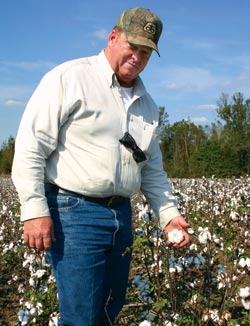Macon County Farmer Wins High Cotton Award

Shep Morris doesn’t follow the crowd when making decisions that affect his central Alabama farming operation, and it’s a trait that has served him well over the years.He was the first producer in his area to use minimum-tillage and cover crops over his entire farm, and one of the first to apply chicken litter as fertilizer. He also was one of the first to incorporate Roundup technology into his entire cotton crop. And, in recent years, he has made the transition back to conventional cotton varieties, in an attempt to improve quality and turnout.This willingness to embrace change, even if he finds himself alone doing it, helped earn Morris the 2005 High Cotton Award from Southeast Farm Press.Morris has worked over the years to perfect a dryland, minimum-tillage system that works for his unique and diverse soil types and geographical regions. His 1,300 acres of cotton and 1,000 acres of corn are spread out over about 40 miles and several different soil types in Macon and Montgomery counties.”We’re not quite at a 50/50 corn-cotton rotation, but that’s what we’re working toward,” he says. “Corn pulls phosphorus from the soil while cotton pulls potassium. Grain contributes nitrogen and phosphorus while the stalks leave one half percent potash and 1 percent nitrogen, which is what the cotton needs. By bedding the corn stubble, nitrogen and potash are built up for the cotton.”Morris “re-hips” his cotton land every fall, putting out potash and phosphorus or chicken litter. “On our corn, we go back and plant straight into our old cotton land. We’re all conventional on our varieties. This is our third year of going back to conventional, after planting all Roundup Ready and stacked-gene varieties in 1998-99. We went back to conventional because of its improved quality and turnout. In addition, we haven’t been spraying for worms here, so we didn’t necessarily need the stacked-gene cotton,” Morris said.He started with the cotton/corn rotation in 1996 and hasn’t looked back.Generally speaking, corn cleanses the soil, notes Morris. “A lot of seedling diseases and nematodes attack cotton but can’t survive in the corn. The corn leaves a lot of dry matter, but it also has a fibrous rather than a woody root system like cotton. It softens the ground, especially our hard ground that tends to crust in the spring,” he said.Corn also helps in minimizing labor and equipment needs. “Because of the timing in planting corn and cotton, we can use the same planter to plant both crops,” Morris said. “Different harvesting equipment is required, but we can use the same labor. We can start harvesting corn around July 10 and continue throughout July and August. Then, we can start picking cotton. In addition to the rotational benefits of the two crops, it also lowers our production costs. If we planted wall-to-wall cotton, we would need two planters and a larger picking crew. Our costs would rise considerably.”In the fall, Morris plants rye as a cover crop over all of his acreage. “Before we began planting no-till, we were planting rye and vetch together. The growth was getting away from us, so we changed to wheat and learned to do a better job of managing it. We went back to rye because it grows better in cool weather and it gives us nematode suppression.”Morris flies on his rye crop after bedding fields in the fall. He has been flying his own plane for about 29 years, and it’s a skill that he uses to his maximum advantage. “We put out the majority of our burndown products with a plane. We also put out all of our in-season herbicides with the plane. In addition, we use it for flying on thrips control, for plant bug control, Pix, and for defoliation,” he said.After corn is harvested, he goes back in the early fall with a glyphosate product to prevent weeds from going to seed. “We don’t have the severe insect problems we once did, but the plane is still a very useful tool,” said Morris.Morris is in the early stages of using precision technology on his farm. “We have a yield monitor on our combine and cotton picker. We’ve been using this technology for three years, and I’m beginning to see some promise. We’ve learned a lot–your eyes can be deceptive when you’re trying to determine how much cotton will yield. With a yield monitor, your best cotton usually is about waist high rather than chin high. Cotton can look mediocre but turn out very good,” he said.Morris has had great success in recent years using poultry litter as fertilizer. “We’ve been putting out poultry litter for about three or four years. We put it out in the fall, bedding it up ahead of cotton. Then, we come back and put it out on corn in the spring to better utilize the nitrogen. It’s great for supplying phosphorus and potash. We learn something new each time we use the poultry litter. We’re getting some residual nitrogen from the litter, which is very good considering the cost of nitrogen fertilizer.”But you have to be aware of these residual properties and manage them,” he said. “With cotton, you need to be prepared to knock it back. It’s not a bad problem to have, but it’s something you need to be aware of. Litter is a very good value for the amount of money we’re spending.”Morris markets his cotton crop through the Autauga Quality Cotton Association and serves on the group’s board of directors. He was one of the founders and serves as vice president of the Milstead Farm Group, Inc., cotton gin and is on the board of directors for First South Farm Credit in Jackson, Miss.Morris and his wife Rite have two sons and a daughter–Shep, Jr., J.W. and Beverly–and all are involved in the farming operation.Paul Hollis is the editor of Southeast Farm Press.
